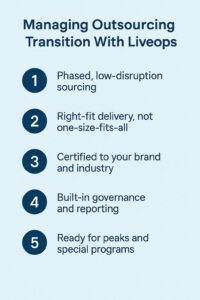How to Transition from an In-House to Outsourced CX Team (Without Disruption)
minutes

Shifting customer service from an internal team to an external partner is one of those changes that can unlock efficiency, coverage, and scale—but it can also go sideways if it’s rushed.
Customers don’t care that you’re “in transition.” They care that someone answers quickly, understands their issue, and fixes it fast. That’s why the way you manage the outsourcing transition matters as much as the decision to outsource in the first place.
This guide walks through how to outsource CX services in phases, how to outsource customer experience management without losing your brand voice, and which controls to put in place so leadership stays confident throughout the rollout.
Start With the “Why” Before You Outsource CX Services

Before you send a single process to a partner, get aligned internally on the reason you’re outsourcing. That clarity will drive scope, KPIs, and timing.
Most organizations move to outsource CX services because they want to lower total service costs, access experienced talent faster than they can hire, or gain the ability to flex up for seasonality without carrying that headcount all year.
Others want more operational discipline—QA, workforce management, reporting—that a mature outsourcing partner already has in place.
Documenting that business case up front will make it easier to decide what to transition first and what to keep in house a bit longer.
Document First, Transition Second
One of the biggest mistakes in managing outsourcing transition is handing off work that isn’t fully documented. If your knowledge base is outdated, or if a lot of “how we actually do it” lives in people’s heads, the partner will struggle—and customers will feel it.
So before you outsource customer experience management, do a quick readiness pass:
- Capture your top contact reasons, channels, and 60–90 days of volume.
- Update process guides, compliance requirements, and escalation paths.
- Label which interactions are routine (good for phase 1) and which are high-emotion or high-risk (better for phase 2 or 3).
Think of this as giving the partner your “source of truth.” The better the inputs, the smoother the delivery.
How to Outsource Customer Experience Management in Phases

You don’t have to flip a switch and send everything to the outsourcer on day one. A phased approach protects the customer and gives you time to measure.
Phase 1: Knowledge Transfer and Access
In this stage, your team walks the partner through real cases, tools, and brand tone. The goal isn’t volume yet—it’s accuracy. Make sure the partner can log in to your CRM or ticketing system, follow your authentication steps, and see the same customer information your in-house team sees.
Phase 2: Limited Live Volume
Once the partner understands the work, let them handle a small percentage of real interactions—often your simpler, repeatable ones. This is the safest way to outsource CX services early because you can compare their performance to your in-house baseline. If their CSAT is close and their handle time is reasonable, you’re ready to expand.
Phase 3: Broader Rollout
Now you can add more contact types and maybe more channels (for example, starting with voice, then adding chat or email). This is where managing outsourcing transition becomes an actual operating rhythm: weekly check-ins, QA reviews, and adjustments to scripts or knowledge articles.
Phase 4: Optimize and Scale
At this point, you and the partner should be looking at the same dashboards. You can start planning for peak, testing AI assist or deflection, and deciding what else to move out of the in-house queue. McKinsey has noted that better customer journeys can reduce service costs while increasing loyalty, which is exactly the upside you want to capture in this phase.
Controls That Keep Leadership Confident
Even when you outsource customer experience management, you still own the customer promise. That means you need visibility.
Set up a simple governance model:
- A weekly meeting for the first 60–90 days to review volume, SLAs, CSAT, QA, and escalations.
- Shared reporting so you can compare in-house vs. outsourced performance apples-to-apples.
- A change-management channel for updates to policies, promos, or compliance.
This is also where brand protection lives. If you’re in a regulated industry—healthcare, insurance, financial services—make sure the partner can support your security and compliance requirements. That’s part of managing outsourcing transition, too: the customer experience can’t be great if the controls aren’t.
What to Watch Right After You Outsource CX Services
The first 30–60 days tell you most of what you need to know. Keep an eye on:
- CSAT/NPS movement. A small dip at the start isn’t unusual, but it should recover as the partner’s team gets familiar with your scenarios.
- Quality scores. Random evaluations should show that agents are following the process, using the right tone, and resolving accurately.
- Speed to scale. One of the reasons to outsource CX services is that you can ramp faster than you can hire internally. If the partner can add coverage for a campaign, weather event, or tax/enrollment season quickly, that’s a sign the model is working.
- Internal time saved. If your ops or product teams are fielding fewer escalations, the outsourcing shift is doing what it should.
Customer-centric companies have been shown in Deloitte research to be more profitable than those that aren’t, which is a helpful proof point when you’re explaining to executives why investing in a smooth transition—not just a cheap transition—matters.
How This Supports Long-Term Customer Experience Management

Once the initial rollout is stable, you can start doing the things that were hard to do with a fully in-house model:
- Align support hours to actual demand instead of keeping the same schedule year-round.
- Add new channels (chat, social, secure messaging) without building the entire function internally.
- Test AI-assisted responses or smarter knowledge surfacing to reduce handle time.
- Create tiered support, where the outsourced team handles the bulk of interactions and your in-house specialists focus on complex, high-emotion, or high-value customers.
That’s when you’ve truly moved from “we outsourced a queue” to “we outsource customer experience management strategically.”
Bringing It Together
A move from in-house to outsourced support doesn’t have to be disruptive. If you:
- Define the business case up front,
- Clean up your documentation,
- Roll out in stages,
- Keep reporting shared and transparent,
- And partner with a provider that knows how to schedule, certify, and scale delivery,
You can protect customer satisfaction while gaining the cost control and agility that outsourcing is supposed to deliver.
Keep weaving those three concepts through your plan—outsource CX services, outsource customer experience management, and managing outsourcing transition—and you’ll have the right language for leadership, for your ops team, and for your provider.
Managing Outsourcing Transition With Liveops: A Low-Disruption Approach

If you want to hand off service without putting your customers through a rough patch, you need a partner that already runs programs this way. Liveops is built for that.
- Phased, low-disruption sourcing
Liveops can mirror the exact phased approach in this blog: discovery and knowledge transfer first, limited live volume to prove performance, then a measured ramp. That means youdon’t have to move 100 percent of contacts at once, and your internal leaders can see side-by-side performance before expanding. - Right-fit delivery, not one-size-fits-all
Because Liveops uses a remote-first delivery model and a large network of experienced customer service professionals, you can align coverage to actual demand instead of fixed seats. That’s what makes outsourcing feel seamless on the customer side—wait times stay consistent even when volume shifts. - Certified to your brand and industry
Service professionals within the Liveops network are certified on your processes, compliance requirements, and customer tone before they take a single interaction. That reduces the “learning on the customer” problem that can happen with some outsourcing transitions. - Built-in governance and reporting
Liveops programs are set up with regular performance reviews, QA, and transparent reporting, so you can compare in-house metrics to outsourced metrics easily. That’s exactly what you need when you’re managing outsourcing transition and your execs want proof that quality isn’t slipping. - Ready for peaks and special programs
If you have open enrollment, tax season, retail holidays, or event-driven spikes, Liveops can add coverage faster than most internal teams can hire.That’s often the moment companies first decide to outsource customer experience management—Liveops just makes it repeatable.
So if your goal is to move work off your internal team, protect customer satisfaction, and come out with a more scalable model, Liveops can run the entire play: document, phase, launch, and optimize—without disruption to the people calling, chatting, or messaging your brand.
FAQs
Q1: What does it actually mean to outsource CX services?
Outsourcing CX services means moving some or all of your customer-facing interactions (voice, chat, email, social, sometimes help desk) to an external service provider that already has the people, workflows, quality assurance, and technology to support your customers. The goal is usually better scalability, lower overhead, and more consistent service quality.
Q2: How is outsource customer experience management different from basic customer service outsourcing?
Outsource customer experience management is broader. It doesn’t just answer tickets; it looks at the full customer journey across touchpoints, collects feedback, uses analytics, and aligns to brand standards. It’s CX plus governance, not just a queue of calls.
Q3: What’s the first step in managing outsourcing transition so it doesn’t hurt customer satisfaction?
Start with knowledge transfer. Get your knowledge base, workflows, escalation rules, and regulatory compliance requirements documented, then let the provider shadow real interactions. When the information is clean, the transition is smoother.
Q4: Can we outsource CX services and still run an omnichannel experience?
Yes. A mature outsourced contact center can support voice, chat, email, and sometimes social, using integrated tools (CRM, ticketing, QA). You just need to agree on channel SLAs and how conversations move between channels.
Q5: How do we keep data security and compliance intact when we outsource customer experience management?
Build data security into the contract and onboarding. Your provider should support secure access, audit trails, and the standards your industry needs (for example, SOC 2 or other regulatory compliance). Access should be role-based and tied to workforce management rules.
Q6: What KPIs should we watch right after transition?
Watch customer satisfaction, first contact resolution, service level/response time, and quality assurance scores. Together, those tell you whether service quality stayed stable while you were managing outsourcing transition.
Q7: Can outsourcing help with scalability during peak seasons?
That’s one of the biggest advantages. An outsourcing partner can add trained customer service professionals faster than most in-house teams can hire, which improves operational efficiency and protects customer experience during spikes.
Q8: How do we make sure the outsourced team understands our brand and tone?
Include brand, language, and empathy standards in the certification/onboarding phase. Share real examples, not just policy docs. Ongoing QA and feedback loops will keep the experience on brand.
Q9: What role does technology play in an outsourcing model?
Technology (CRM, workforce management, QA tools, sometimes artificial intelligence for assist) makes the outsourced team act like an extension of yours. It keeps reporting consistent and gives you transparency into service delivery.
Q10: Is business process outsourcing the same thing as outsourcing CX services?
They overlap, but they’re not identical. Business process outsourcing (BPO) can include back-office and non-customer tasks (accounting, HR processes, data entry). Outsource CX services focuses specifically on customer-facing work and the experience layer.
Q11: How do we protect customer retention during transition?
Keep customers’ wait times and first-response times steady, and make sure the provider is resolving issues on the first interaction. If those stay healthy, customer retention and brand loyalty won’t take a hit.
Q12: What if we already use tools like Zendesk or other CRM platforms?
Most outsourcing providers can plug into your existing customer support software so you keep ownership of data and reporting. That way, you don’t lose visibility into customers, tickets, or performance.
Related Resources
Stop outsourcing, start outsmarting
Join the brands redefining customer experience with Liveops. Empathetic agents, tech-powered delivery, and the flexibility to meet every moment. Let’s talk.

Explore flexible customer experience solutions




